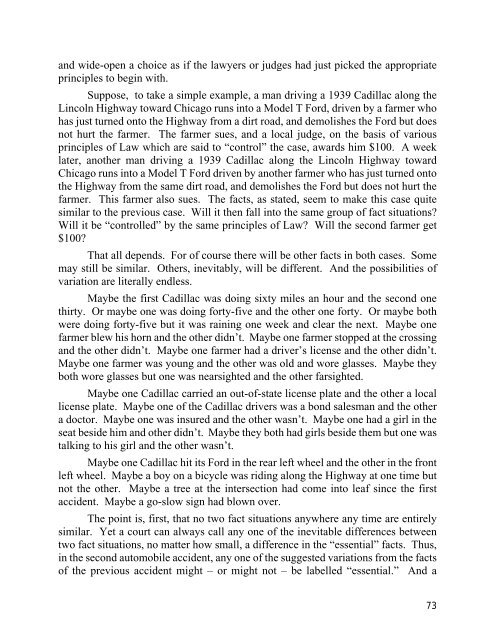WOE UNTO YOU, LAWYERS!
WOE UNTO YOU, LAWYERS!
WOE UNTO YOU, LAWYERS!
Create successful ePaper yourself
Turn your PDF publications into a flip-book with our unique Google optimized e-Paper software.
and wide-open a choice as if the lawyers or judges had just picked the appropriate<br />
principles to begin with.<br />
Suppose, to take a simple example, a man driving a 1939 Cadillac along the<br />
Lincoln Highway toward Chicago runs into a Model T Ford, driven by a farmer who<br />
has just turned onto the Highway from a dirt road, and demolishes the Ford but does<br />
not hurt the farmer. The farmer sues, and a local judge, on the basis of various<br />
principles of Law which are said to “control” the case, awards him $100. A week<br />
later, another man driving a 1939 Cadillac along the Lincoln Highway toward<br />
Chicago runs into a Model T Ford driven by another farmer who has just turned onto<br />
the Highway from the same dirt road, and demolishes the Ford but does not hurt the<br />
farmer. This farmer also sues. The facts, as stated, seem to make this case quite<br />
similar to the previous case. Will it then fall into the same group of fact situations?<br />
Will it be “controlled” by the same principles of Law? Will the second farmer get<br />
$100?<br />
That all depends. For of course there will be other facts in both cases. Some<br />
may still be similar. Others, inevitably, will be different. And the possibilities of<br />
variation are literally endless.<br />
Maybe the first Cadillac was doing sixty miles an hour and the second one<br />
thirty. Or maybe one was doing forty-five and the other one forty. Or maybe both<br />
were doing forty-five but it was raining one week and clear the next. Maybe one<br />
farmer blew his horn and the other didn’t. Maybe one farmer stopped at the crossing<br />
and the other didn’t. Maybe one farmer had a driver’s license and the other didn’t.<br />
Maybe one farmer was young and the other was old and wore glasses. Maybe they<br />
both wore glasses but one was nearsighted and the other farsighted.<br />
Maybe one Cadillac carried an out-of-state license plate and the other a local<br />
license plate. Maybe one of the Cadillac drivers was a bond salesman and the other<br />
a doctor. Maybe one was insured and the other wasn’t. Maybe one had a girl in the<br />
seat beside him and other didn’t. Maybe they both had girls beside them but one was<br />
talking to his girl and the other wasn’t.<br />
Maybe one Cadillac hit its Ford in the rear left wheel and the other in the front<br />
left wheel. Maybe a boy on a bicycle was riding along the Highway at one time but<br />
not the other. Maybe a tree at the intersection had come into leaf since the first<br />
accident. Maybe a go-slow sign had blown over.<br />
The point is, first, that no two fact situations anywhere any time are entirely<br />
similar. Yet a court can always call any one of the inevitable differences between<br />
two fact situations, no matter how small, a difference in the “essential” facts. Thus,<br />
in the second automobile accident, any one of the suggested variations from the facts<br />
of the previous accident might – or might not – be labelled “essential.” And a<br />
73


